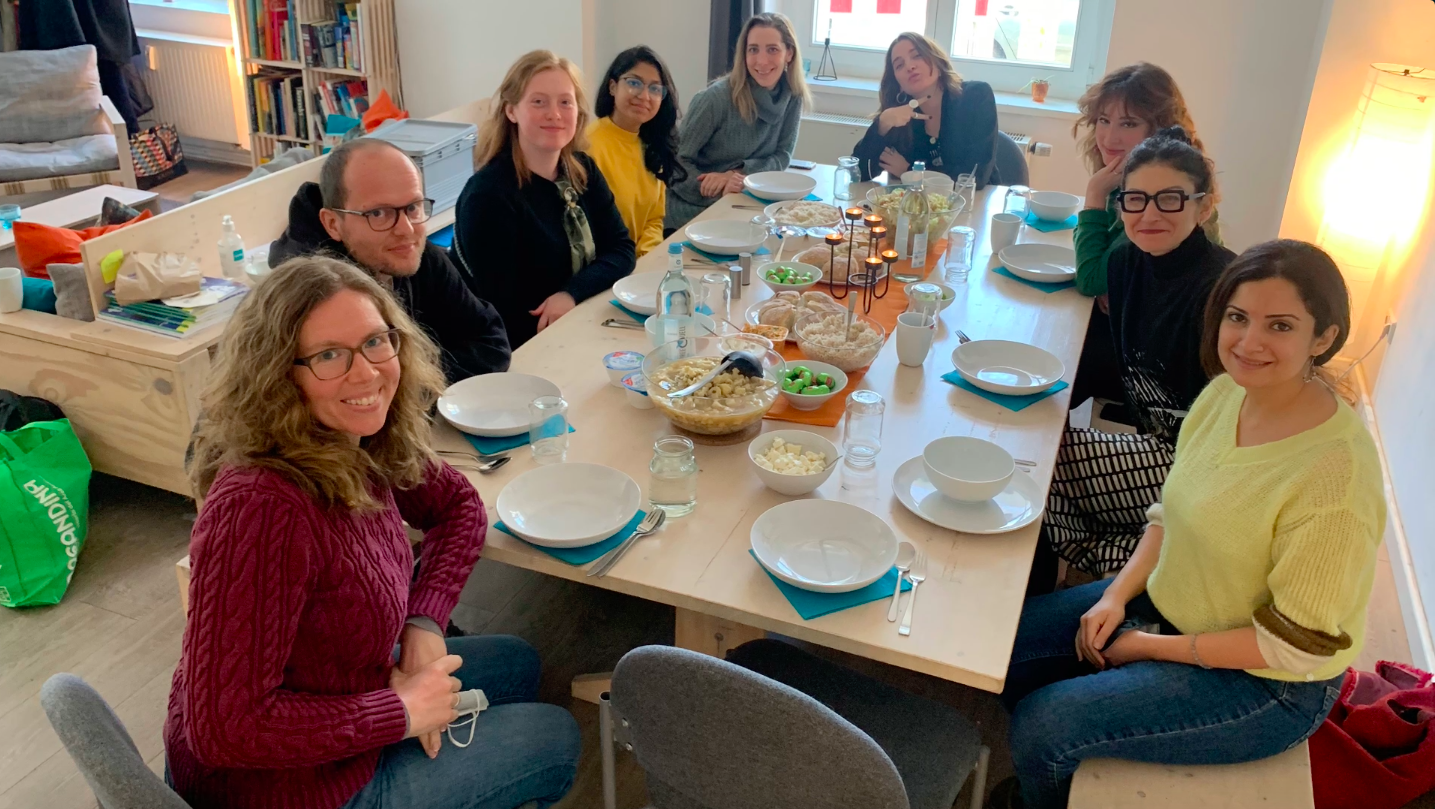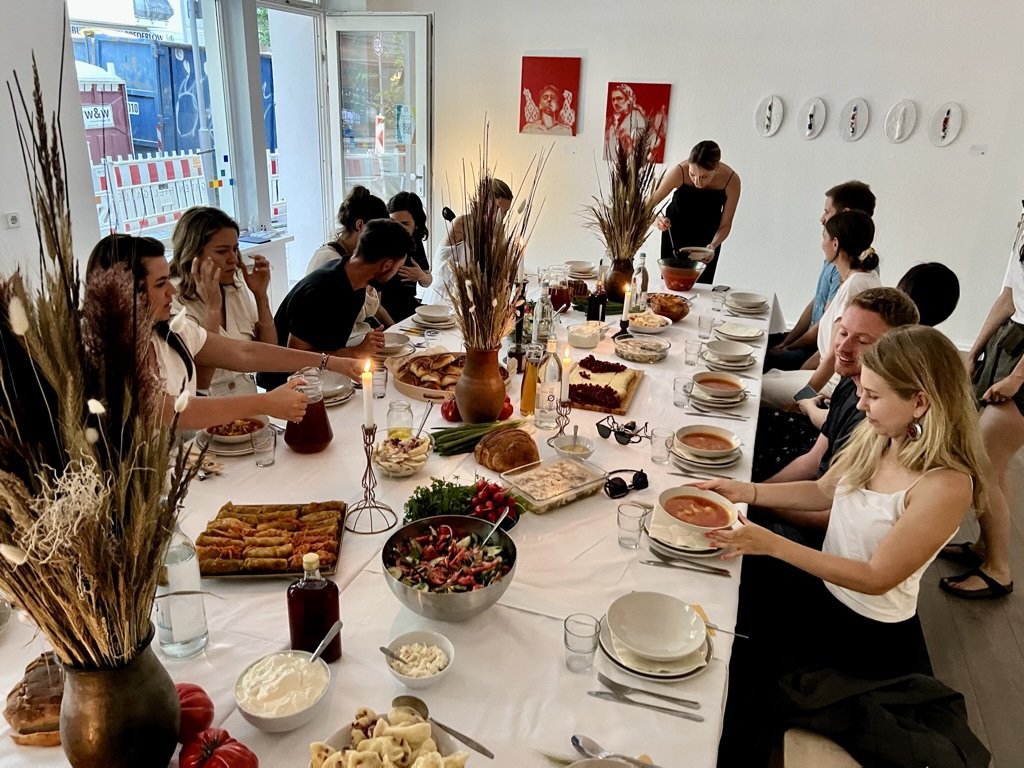On Monday, 23.1, Federal Minister of the Interior Nancy Faeser came to Kulturschöpfer to have a podium discussion on Immigration and Integration. Before sharing about her time with us, I wanted to address how we at Kulturschöpfer view these topics.
Immigration and Integration
These two words can be buzzwords, and there can be many misunderstandings. Both positive and negative feelings might arise when you hear the two words, either separately or together. Those feelings and emotions depend a lot on your own story, your own experience with either an immigrant or with immigration personally, and how you might have observed or experienced integration positively or negatively. We must recognize that each of us brings our own baggage, our past experiences which can be both positive and negative, in regards to this topic. Immigration and integration can be quite controversial topics and they can create conflict and misunderstandings between people and in communities. This is why I want to clarify how we define these terms so that we come from the same understanding.
Immigration: the act of someone coming to live in a different country
This is the definition from Cambridge Online Dictionary that we will be using as our basis for talking about immigration. Yes, there are several types of immigration, including economic immigration, family immigration, asylum immigration, and forced immigration. Economic immigrants move to a new country in search of job opportunities and a better standard of living. Family immigration involves reuniting with loved ones who have already immigrated to a new country. Asylum immigration involves seeking protection from persecution or harm in one's home country. Forced immigration refers to individuals who are displaced from their homes due to war, conflict, or natural disasters. However, we will be keeping with the basic definition of someone coming to live in a different country.
Integration: To combine two or more things into one
To become part of a group of people are the two basic definitions from Cambridge Online Dictionary that we will be using. Regardless of the type of immigration, integration plays a crucial role in promoting mutual respect and understanding among different groups in the new society. A healthy integration process requires the involvement and active participation of all parties, including the immigrant and the host community. Building a sense of belonging and inclusion through integration can foster a more harmonious society where everyone feels valued and respected, regardless of their background. It is important to recognize that integration is a two-way street and requires mutual respect and understanding between the immigrant and host communities. Encouraging and supporting integration efforts can lead to a more inclusive society for all, where everyone is able to contribute and feel valued.
One keystone to our space is creating a safe place
It is a place where people feel that they are not only welcomed but also at home. To do so, they need to feel integrated into our community and feel that they feel known and belong. One of the ways that we do this is by sharing that we have a lot more in common than the differences that might appear at first glance or, for that matter, first conversation. I have had the privileged of not only hearing the stories of many diverse people at Kulturschöpfer, but I have also had the privileged of traveling the world and hearing people's stories in their home country. One thing I have realized is that we, as humans, have much more in common than we do differences, despite age, culture, religion, or even politics. We all, each one of us, have longed to know beauty, to discover our identity, and to experience community. We all want to experience peace in our lives, and that peace cannot be reached until those longings are fulfilled!
The Meeting with The Federal Minister Nancy Faeser
Photocredit: Ralph Pache
As I prepared for Minister Faeser's visit and discussion on Immigration and Integration, it became that much more apparent just how Kulturschöpfer is and has been, a place for immigrants as well as for integration. For years, we never saw this because we saw ourselves as a place of community for those who feel that they have not found a place to be known or to belong. However, currently, in our space, we have 16 Nationalities represented in our community of 42 people, 38 % of our community are immigrants. They have come here for various reasons, study, work, relationship, fleeing war, a new start, or internship with us. There are many languages spoken, but we focus on the language of respect and appreciation for one another. For most of our existence, that has been the case and has only continued to increase as the demographic of our neighborhood also changed.
Kulturschöpfer: a story of daily integration
As we reflected, we realized how much of our story, as an organization and the individuals that comprise it, is of immigration. It is even my personal story, being an immigrant that has lived here in Berlin for 17 years. In our gallery at Kulturschöpfer, we have had several topics addressing the topic of immigration, integration, and community. We have had workshops for refugees and are partnering with local schools with high migration backgrounds. Our everyday life in the center is grounded in integrating each person into the community with a basis of cultural understanding. Whether it be our Gathering Lunches, morning coffee, or our concert series with diverse cultural bands. Our training program is also constantly bringing in 4-6 interns from 4-6 different countries, and our residency program that is bringing in 4-7 artists from 4-7 different countries. Our heart is to be a space where people finally have a home in Berlin, where they are accepted and feel that they belong.
Struggles and challenges for integration
Photocredit: Ralph Pache
In my discussion with Minister Faeser, I discussed the struggle and challenge for integration to be done well. The problem, from my perspective, is that integration is seen as a project, not as a lifestyle. This is even more apparent in funding opportunities for the integration of immigrants. If there is to be a focus on making immigration easier and faster, and if integration is a foundational element, according to Frau Faeser, there must be another approach for it to be done well. At Kulturschöpfer, we always talk about people over projects, and we do not want to lose sight of people's hearts and who they are as humans. Funding opportunities take the human aspect out and instead focus on projects. Integration takes time. There is no other way of getting around that for a good healthy, sustainable, thriving, integrated community. There needs to be long-term institutional funding over short-term project-based funding in order for there to be healthy, sustainable integration of immigrants. We were greatly encouraged by the very positive remarks that Minister Faeser shared about Kulturschöpfer and the approach we have towards integration and the encouraging stories and examples of a community that is thriving, which includes an over-average percentage of immigrants in our community compared to Berlin's average. I was also thankful for her open ear, for hearing the struggles we have funding our organization, and for her desire for institutional funding. I hope there is an actual change that comes from our conversation. As we say in Kulturschoepfer, talk is cheap; we are made to create!
Culture-sustainer or culture-maker?
Photocredit: Ralph Pache
Our organization's name is Kulturschöpfer, which means Culture Maker. We each have the possibility to influence the culture, to change the culture, and we want to be a place where we encourage and equip one another to have a positive influence on the culture around us, whether it be in our home, our business, friendship circle, neighborhood or Berlin for that matter. One of the realities is that it is really easy to become a cultural sustainer, to be content with how things are, not how they could be. However, we have had to adapt, to change; in order for us to continue to be Culture Makers, we have to have a continual pulse on the culture, the neighborhood that surrounds our space, and the city of Berlin in which we find ourselves. We need to be asking ourselves, as individuals, as leaders, and as a country, have we become cultural sustainers or culture-makers? Do the policies and funding in place help to change the culture for the postive or is it just maintaining the status quo? Honestly, it is easy to fall into the rut of being a cultural sustainer; we become comfortable with how things are, which limits our ability to see how things could be. Change challenges us because it is uncomfortable. Change often causes conflict within communities, but we at Kulturschöpfer desire to see conflict as the breeding ground of creativity, of potential. Each person at Kulturschoepfer we see as being created equal; there is not divide between immigrants and non-immigrants. Each person brings their own story, experiences, strengths, gifting, and passions. They bring their creativity and perspective, which we would not have without them. Our diversity, in the fullness of the term, keeps us on our toes; we are always learning, always changing, and most importantly, always growing. Our organization would not be where we are today if not for the creativity, energy, and passion that our diverse community has brought into our space. It is a place where we can create and collaborate because we no longer fear one another and the threat that they might be but see them as a gift and what they have to bring and how we can achieve something far greater together than what we could alone. This inspires us that there is another way. It is like breathing; it brings us life, and a new energy and possibility can be reached. We can imagine how things could be and not be settled with how things are.









